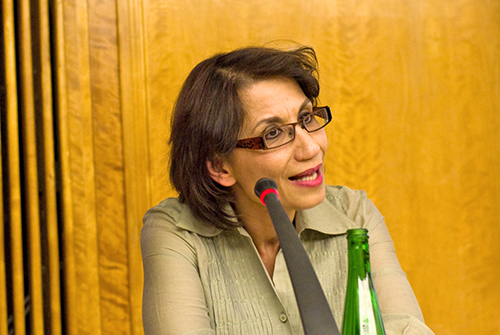|
Vortrag von Ziba Mir-Hosseini, Research Associate, School of Oriental and African
Studies, London

Ca. 90 Besucher hörten den Vortrag von Ziba Mir-Hosseini im Einstein-Saal der Berlin-Brandenburgischen Akademie der Wissenschaften

Schirin Amir-Moazami von Viadrina-Universität in Frankfurt/Oder (links) moderierte die Veranstaltung

Die Referentin Ziba Mir-Hosseini
Die international angesehene Wissenschaftlerin und Dokumentarfilmerin
ergreift seit Jahren zu dem brisanten Thema der Verhüllung
des weiblichen Körpers im Islam und zu Geschlechterfragen
das Wort. Sie ist Anthropologin und auf islamisches Recht spezialisiert.
Zu diesen Themenfeldern hat sie nicht nur durch zahlreiche einschlägige
Publikationen internationale Bekanntheit erlangt, sondern auch
durch ihre Dokumentarfi lme „Divorce Iranian Style“
(1998) und Runaway (2001). Die Debatte entzündet sich oft
an dem Umhang (Hijab), den auch Mir-Hosseini in ihrem Vortrag
thematisieren wird:
Hijab, or covering of a Muslim woman‘s body, is the most
visible Islamic mandate. For a century it has been a major site
of ideological struggle between traditionalism and modernity,
and is often seen as an indicator of the emancipation or repression
of Muslim women. It has recently pitted Islamist and secular
feminist rhetorics against each other. For Islamists, hijab
represents their distinct identity and religious authenticity.
They claim it is a divine mandate that protects women and defi
nes their place in society. For secular feminists, hijab represents
women‘s oppression. They see it as a patriarchal mandate
that denies women the right to control their bodies and to choose
what to wear. The obsession with the hijab in contemporary discourses
(both Western and Islamic) speaks of its symbolic signifi cance.
Meanwhile Muslim women have begun to challenge conventional
wisdoms, and to redefine the terms of their public presence.
In doing so, they are confronting prevailing notions of hijab,
giving it a new meaning and symbolic value.
|